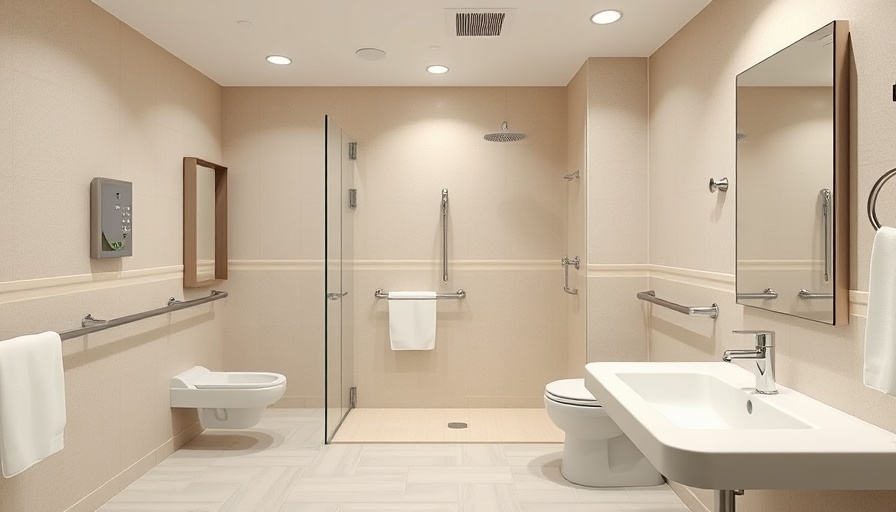
Understanding the Significance of Accessible Bathrooms
Across the United States, the conversation around accessibility is gaining clarity and momentum, and no state illustrates this push for inclusivity better than New Jersey. The recent updates to bathroom accessibility standards have provided countless individuals with dignity and independence, emphasizing the profound need for public restrooms that accommodate a range of abilities. It's not merely an issue of convenience; this is about ensuring that everyone, regardless of physical capability, has equal access to public facilities.
Many individuals face significant challenges when accessing even basic services due to architectural barriers. Traditionally designed restrooms fail to consider the needs of individuals with disabilities, temporary injuries, or age-related mobility challenges. Advocacy efforts in New Jersey have laid bare the glaring inadequacies of these designs, shedding light on a significant flaw in our societal infrastructure. It’s clear that the push for comprehensive accessibility is both a growing trend and a fundamental human right.
New Jersey’s Legislative Landscape: A Groundbreaking Shift
Legislative changes in New Jersey signal a shift towards prioritizing accessibility within public infrastructure. The updated New Jersey Uniform Construction Code is a testament to this commitment, incorporating more stringent guidelines for public restroom designs. This legislative initiative is not just about compliance; it’s about redefining what accessibility looks like in contemporary society.
Key among these changes is the requirement for accessible stalls equipped with grab bars and wider entryways, making a significant difference for those who might struggle with mobility. The code also emphasizes the importance of visual and tactile signage, ensuring that even those with visual impairments can navigate restroom facilities safely and confidently. Such thoughtful changes reflect an understanding that accessibility must be the forefront of architectural design rather than an afterthought.
Advocacy in Action: The Heart of Change
In addition to legislative efforts, advocacy groups have been instrumental in promoting accessibility in New Jersey. Organizations such as the New Jersey Self-Advocacy Project and various disability rights coalitions are actively engaged in raising awareness and pushing for improvements within public systems. Their outreach initiatives not only educate the public about accessibility issues but also empower individuals with disabilities to advocate for their own rights. This collective movement has fostered a community where members can share experiences, seek advice, and work towards common goals, enhancing the impact of activism and guiding legislative efforts.
Global Perspectives: A Model for Change
The advancement of bathroom accessibility standards in New Jersey has implications beyond state lines. As other regions look towards a more inclusive society, New Jersey serves as a model for what proactive legislative action can achieve. This trend resonates globally, as cities worldwide begin to understand the value of accessibility. Countries are increasingly recognizing that a society built on inclusivity is not only necessary but beneficial for all residents—creating vibrant communities where everyone can participate fully.
By setting an example, New Jersey is encouraging others to take similar steps and invest in accessible designs that speak to the needs of all citizens. Global discussions surrounding accessibility focus on finding innovative solutions that can be replicated elsewhere. As accessibility continues to be a discussion point, New Jersey’s legislative advancements showcase what feasible steps can lead to positive change.
Embracing Inclusivity: Why It Matters
Ultimately, the movement towards accessible bathroom standards in New Jersey serves as a reminder that inclusivity is paramount in our society. For seniors, parents with strollers, and individuals with disabilities, a well-designed restroom can significantly improve quality of life and foster independence. Recognizing the emotional and practical implications of these changes is crucial in understanding their importance.
As more facilities adopt these new standards, we see not only the physical changes in structure but a cultural shift towards acceptance and respect for all abilities. It is an assurance that no one will feel overlooked in public spaces. While New Jersey makes great strides, it’s essential for all of us to join this forward momentum, advocating for accessibility wherever possible.
Call to Action: Championing Accessibility
The voice of change is powerful, and you can be a part of it! Advocating for accessible designs in your community can contribute to the broader push for inclusivity. Whether through attending local council meetings, supporting advocacy organizations, or educating friends and family about the importance of accessibility, every small action counts. As we move forward, fostering a culture that cherishes diversity in all forms will lead us into a more inclusive future.
 Add Row
Add Row  Add
Add 




 Add Row
Add Row  Add
Add 

Write A Comment